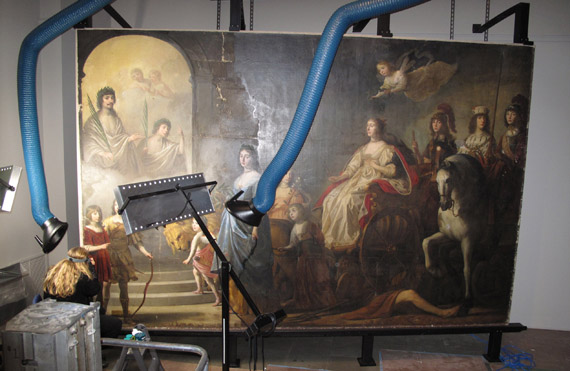His Area of Art Is Sometimes Referred to as the ââåqueen of the Artsã¢ââ
In Jan 2011, conservators raised the curtain on their work as they cleaned and conserved the enormous The Triumph of the Wintertime Queen: Allegory of the Merely by seventeenth-century Dutch principal Gerrit van Honthorst. Conservators unremarkably work backside the scenes, simply this painting is so big (about x x 15 feet) that a new studio infinite was created specially for its treatment. Over the course of xviii months, conservators carried out their work on view to the public; see the progress updates posted below.
The Painting
Signed and dated in 1636, the painting is function apologue, part family portrait. Elizabeth Stuart, the recently widowed "Winter" Queen of Bohemia who was living in exile in the netherlands, probably deputed the painting for a hunting lodge at Rhenen, nigh The Hague. Scepter in paw, Elizabeth sits atop a wagon drawn by 3 lions. She is surrounded by her 13 children, some living and some dead. Among the latter is her eldest son, Frederick Henry, who appears at upper left with his father, the deceased "Winter" Rex; both agree palm branches and are bathed in a golden, celestial calorie-free. The effigy under the chariot's wheels is Neptune, ancient Roman god of water and the body of water, whose trident pokes out from under the cart. He is getting his due. The painting's title, The Triumph of the Winter Queen: Allegory of the Just, alludes to the fact that Frederick Henry had drowned in an blow in 1629.

A. Elizabeth, 1596–1662; B. Frederick V, 1596–1632; one. Frederick Henry, 1614–1629; 2. Charles Louis, 1617–1680; three. Elizabeth, 1618–1680; 4. Rupert of Rhine, 1619–1682; five. Maurice, 1620–1652; 6. Louise Hollandine, 1622–1709; 7. Louis, 1623–1624; 8. Edward, 1625–1663; 9. Henrietta Maria, 1626–1651; 10. Philip, 1627–1650; 11. Charlotte, 1628–1631; 12. Sophia, 1630–1714; thirteen. Gustavus Adolphus, 1632–1641.
The Winter Male monarch and Queen accept their nicknames from the shortness of their reign. They were actually Frederick Five, Elector (ruler) of the Palatinate, and Elizabeth Stuart, daughter of England'southward King James I. In 1619 Frederick, who ruled portions of Germany, was selected equally King of Bohemia (roughly today's Czechia). Fundamental Europe was divided by fierce religious and political conflict at the time, and Frederick's selection helped ensure the slide into war. Frederick was a Protestant, equally were many of his Bohemia subjects, but about of the surrounding powers were Roman Catholic. Equally soon as Frederick was crowned, the Holy Roman Emperor, a Cosmic, claimed Bohemia as well. Subsequently only a yr in power, Frederick and Elizabeth were driven into exile; the disharmonize was a cardinal early moment in the Thirty Years' War that ravaged central Europe.
Honthorst had spent a decade studying in Rome, where he was influenced by the work of Caravaggio. However, by the time Elizabeth deputed him to create a pair of grand allegorical paintings, he had moved to a courtlier, more refined and colorful painting style. One of these ii portraits, which survives merely as a fragment, explored the family's trials and hardships. The other, The Triumph of the Winter Queen, was used by Elizabeth to affirm her family's right to the Palatinate and to convey her confidence that they would succeed in overcoming their misfortunes. Elizabeth, who died on February 13, 1662—the day before what would have been her 49th nuptials anniversary—lived to see her son, Charles Louis, regain control of some of these lands in 1648 with the end of the Thirty Years' War. Merely it was through her daughter, Sophia of Hanover, whose son became King George I of England, that the legacy of Elizabeth Stuart and Frederick V continues to this day.
Conservation Strategy

The painting is in remarkably skillful condition given its age, size, and many travels. There are some tears and other impairment, just those accept recently been repaired past "lining" the canvas—or adhering a new piece of cloth to the dorsum. The painting is as well much darker than the artist intended. Centuries' worth of grime, discolored varnish, and old repaint have accumulated on the surface. The aim is to remove this veil.
A thorough technical examination will be conducted during treatment, using a number of scientific techniques to determine the painting'southward original construction and current status. Diverse tools allow conservation scientists to come across underneath the pigment surface, including ultraviolet free energy ("black" light), infrared energy, and the analysis of tiny cross sections of paint under magnification. Information from these tests will help build a clearer motion-picture show of how the painting was made and how it has changed over time. That noesis, in turn, will help conservators make decisions most treatment—what to do and how to do it.
Inevitably, the process volition reveal areas of harm, as old repairs, as well as dirt and varnish, are removed. Afterward cleaning, the process to restore the damaged parts volition involve carefully filling the areas of loss with a putty-like material similar to the one Honthorst used for the painting's ground layer. These areas will then be painted using chemically stable paints that are specifically fabricated for this purpose. When the treatment is complete, the repairs will be imperceptible and viewers will exist able to savour the painting as Honthorst, and the Wintertime Queen, intended.
Conservation in Activity

See below for updates equally treatment progresses.
January 2011
Apr 2011
July 2011
November 2011
Apr 2012
July 2012
Source: https://www.mfa.org/collections/conservation/conservationinaction_allegoryofthejust
Post a Comment for "His Area of Art Is Sometimes Referred to as the ââåqueen of the Artsã¢ââ"